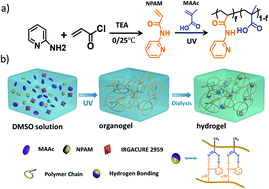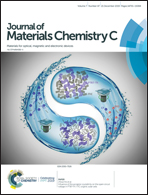A novel 3D-printable hydrogel with high mechanical strength and shape memory properties†
Abstract
The three-dimensional (3D)-printing of hydrogels with excellent mechanical properties has attracted extensive attention owing to their potential applications in many fields. Through the photoinitiated copolymerization of methacrylic acid (MAAc) and N-(pyridin-2-yl)acrylamide (NPAM) in dimethylsulfoxide (DMSO), a copolymer solution was prepared; it was then 3D printed at 70 °C followed by solvent replacement of DMSO with water at 25 °C, and a novel 3D-printed tough hydrogel was prepared. In the presence of water, NPAM could undergo “multi-fold” hydrogen bonding with MAAc. Thus, the hydrogen bonding is strengthened and stabilized by the hydrophobic α-methyl of MAAc and the pyridine N-heterocycle of NPAM, meaning that the modules of the hydrogel can be up to five times stronger than the original organogels. The swelling or shrinkage of the gel is negligible during solvent replacement and the resultant hydrogel exhibits excellent mechanical properties, with an elastic modulus of 1.8–66 MPa, a tensile fracture stress of 2.2–6.3 MPa, a fracture strain of 360–570% and a fracture energy of 0.5–7.2 kJ m−2. In addition, owing to the dynamic nature and temperature sensitivity of the hydrogen bonds, the hydrogel also exhibited fast self-recovery abilities and temperature activated shape memory properties. In particular, the hydrogen-bonding hydrogel could be quickly degraded and recovered by adjusting the pH, which allowed convenient recycling of the hydrogels. Our experimental results indicated that the combination of a 3D-printing technique and solvent replacement may provide a novel and effective method to obtain 3D-printed hydrogels with high mechanical strength and shape recovery properties, fostering their use in a number of fields such as soft robots, implant devices, tissue engineering and other environment friendly materials.



 Please wait while we load your content...
Please wait while we load your content...